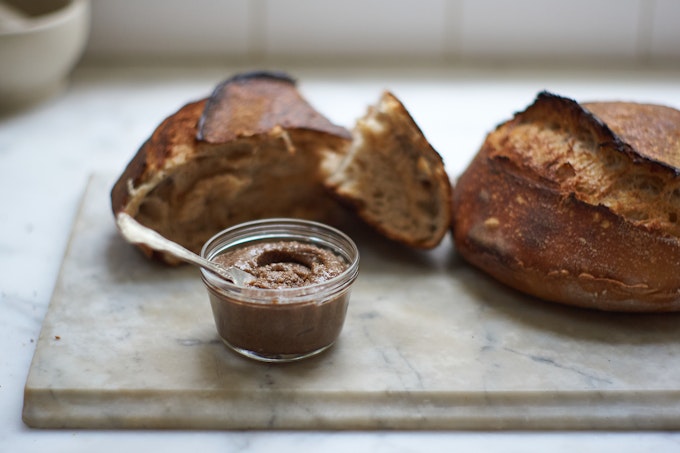Seared Tuna Steak
This perfectly seared tuna steak is ideal as an easy weeknight dinner—it’s one of my favorite protein-packed pescatarian recipes! Here are my expert tips for cooking this tasty fish and top ideas for ways to serve it.

This perfectly seared tuna steak is ideal as an easy weeknight dinner—it’s one of my favorite protein-packed pescatarian recipes! Here are my expert tips for cooking this tasty fish and top ideas for ways to serve it.

Tuna steak is one of those magical proteins that don’t taste like you’d expect. When cooked well, it tastes less like fish and more like a piece of chicken or steak!
Tuna steaks are one of my favorite meals. They’re high in protein, cook in under 5 minutes, and feel surprisingly gourmet. Their meaty, buttery, melt-in-your-mouth texture and well-seasoned exterior make them perfect for everything from weeknight dinners to impressing guests at a dinner party.
This tuna steak recipe is perfect for pescatarians, tuna fans, or home cooks looking for a quick meal big on fresh, high-quality ingredients. In fact, I love this recipe so much that my husband, Alex, and I made sure to include a rendition of it in our latest book, the A Couple Cooks Cookbook.
Buying Quality Tuna Steaks
This recipe starts with a great piece of fish. Ahi tuna, also known as yellowfin tuna or bigeye tuna, is a mild, lean fish often used in sushi, poke bowls, or cooked rare or medium-rare. It’s sold as thick steaks at the grocery store, not thin fillets like other types of fish.
Here’s what to look for when buying tuna steaks:
- Consider sushi or sashimi grade. There are no specific regulations around the label “sushi-grade,” but it means the fish is high-quality and safe to be eaten raw.
- Check the fish counter. You should be able to find ahi tuna steaks at your local grocery counter. “Regular” tuna generally refers to the canned, albacore, or skipjack types of tuna. (Bluefin tuna is the rarest and most expensive, but it’s not necessary here.)
- Look for frozen steaks. These can be even fresher than fresh tuna if they’re flash frozen right when they’re caught. You’ll just need to thaw them in the refrigerator the night before.
- Find wild-caught fish. Wild-caught fish is usually a more sustainable choice, but quality options are available in well-regulated farms. See the Seafood Watch Consumer Guide.
Best Way to Cook and Sear
This seared tuna steak takes just 2 to 4 minutes, so you won’t want to wander too far away from your skillet. Here are the basic steps for this one (or you can go ahead and jump right to the recipe):

Step 1: Allow steaks to come to room temperature. (Give them about 20 minutes.) This is important. Otherwise, the inside will remain cold while the outside is cooked.

Step 2: Season tuna steaks with salt and pepper. We use about ¾ teaspoon for every 8 ounces.

Step 3: Heat oil in a non-stick or cast iron skillet over medium-high heat and cook the steaks for 1 to 2 minutes per side. They should be browned on the outside but rare on the inside.
The internal temperature of your tuna steaks should be 130°F for medium-rare. You can measure the temperature by inserting a food thermometer into the thickest part of the steak. Allow your steaks to rest for 2 minutes before slicing them into strips.
If you’re serving ahi tuna to children or pregnant women, you won’t want the inside raw. In these instances, cook your steaks to medium; I promise they’ll be just as meaty and delicious! To achieve a medium doneness, cook to an internal temperature around 135°F. It’s still not a pan-fried dish, but your steaks will no longer be pink on the inside.
Tried, Tasted, and 5-Star Approved





“Turned out great! I looked up your tuna steak recipe mainly for the cooking instructions and tips to make sure I didn’t ruin our lovely wild caught fish. I used a light blend of Old Bay seasoning, lemon pepper, and sea salt. Didn’t have any neutral oils, so I used coconut oil and olive oil and the tuna steaks still came out delicious. Moist, tender, flavorful, not overcooked. The whole family loved it!”
– Pamela M.
Serve With Sauces and Sides
I love my garlic herb sauce with fresh herbs and capers for any tuna steak recipe, but it really depends on what you’re going for in your final dish. Here are a few more tasty sauces for seared tuna:
- Hoisin: For Asian-style flavors, try savory hoisin sauce for dipping. It’s sweet and savory for the perfect blend of that elusive umami.
- Ponzu: This Japanese dipping sauce, made with soy sauce and citrus juice, is a nice contrast to the tuna’s meaty flavor.
- Teriyaki: You can pick up a bottle at the grocery store, but I also have an easy recipe for homemade teriyaki.
As for sides, you can pair ahi tuna steaks with just about anything to turn them into a complete, healthy dinner. Here are a few ideas for quick sides that can be made in the time it takes to rest and cook your steaks:
- Grains: Use whatever grain you like, such as quinoa or farro. You could also add rice to make a spin-off version of a poke bowl.
- Salads: Add some extra protein with a white bean salad or keep it fresh and simple with a romaine lettuce salad.
- Pastas: Serve your tuna on a bed of fluffy couscous or orzo with lemon juice for some acidity in your dish.
- Veggies: For a balance of textures, stick to veggies that retain their crunch. I like snow peas or sautéed broccoli.
Tuna Steak
Cooking tuna steaks isn’t complicated, but it does require some attention to detail. Here’s how I get an amazing sear and incredible flavor.
- Prep Time: 20 minutes
- Cook Time: 5 minutes
- Total Time: 25 minutes
- Yield: 2 4-ounce servings
- Category: Fish
- Method: Seared
Ingredients
- 2 8-oz ahi tuna steaks
- ½ tablespoon neutral oil
- 1 ½ teaspoon kosher salt
- Freshly ground black pepper, to taste
Instructions
- Bring the tuna steaks to room temperature by letting them sit for at least 20 minutes. Pat the tuna dry.
- Sprinkle the fish liberally with the kosher salt and fresh ground black pepper on both sides.
- Heat the oil in a medium skillet over medium-high heat.
- Add the tuna steaks and cook 1-2 minutes per side until lightly browned on the outside but still rare on the inside.
- Cool for 2 minutes, then slice the tuna against the grain into ½-inch slices.
- Serve immediately, with a sauce if desired.
Notes
A neutral oil is better than butter for searing tuna steaks because it can handle higher heat without burning. Searing is best fast and hot, so you want oil with a high smoking point, like grapeseed or vegetable oil. Olive oil is fine, but it adds a bit of a different flavor profile to the dish.
Grilled tuna steak is just as quick and delicious as a hot pan. You’ll use the same seasonings but can play with the smokiness when it’s time for sauces. I like my chimichurri sauce with cilantro or a red pepper romesco for grilled fish recipes and summertime dinners.
This tuna recipe doesn’t call for a marinade, but you can always add a quick marinade for extra flavor. Keep it short. About 15-30 minutes in a soy-, citrus-, or sesame oil-based sauce is more than enough for marinated, pan-seared tuna.
FAQs
Tuna steak can generally be eaten raw if labeled “sushi-grade” or “sashimi-grade.” That means the seller has deemed it safe to eat raw because it meets specific processing standards.
You’ll find raw tuna in pokes, tartares, and sashimi. If you’re unsure about the source, you can cook your tuna all the way through.
To make a crusted tuna steak, coat your tuna with a sauce after patting it dry to help your crust ingredients stick. Sprinkle all sides of your tuna with your crust mix, which typically includes sesame seeds, then press it down into each piece. Sear your steaks in the same way from there.




















_Alexey_Kotelnikov_Alamy.jpg?width=1280&auto=webp&quality=80&disable=upscale#)

























































